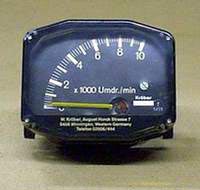23 teeth gets you 112 in third .
Exact instantaeneous Accurate R P M figure shown .KROBER . \
You can SEE IT there , down below .
Now , If its good enough for Pete , Who do you think you are , to disagree .
Around 80 in second . 75 anyway ( No Exact figure ! thereabouts )
76.4705882353 if its 1.7 : 1 . for a fact .
THE PROBLEM IS , one should not downshift - fetching past 3/4 redline. Or 2/3rd .
AND ONLY Throttle On .
Fropple Off , the main loads TENSION . 2 year olds let out of the city downshift their 1600 escorts ,
into second ( because they havnt realised theyre NOT doing 30 mph )when coming into a country town at 80 mph . With Similar Results. Par for the course . B A N G . clatter clatter CLUNK .
DONT lend your vehical to a teenager .
=========================
Reading the Cam Specs ?? , saying Valve Springs & the Redlines 7500 .
Id run 7000 regularly WFO on a Std Cam ( Head & carbs trick ed up ) .
A Problem is Cable drive Magnetic TACH. LAG & innacuracy .
Touched 7200 only a few times . BUT owdya KNOW its 7200 .
Theres a hesitancey .
With A IMPULSE Tachometer , it is INSTANTAENEOUS & Exact . ( if its set exact ) . V D O & Krober - which was Std. 750 fare - in the day .
ooops , so THATS where they WENT ! (

)
Gotcha . THATS a white One . And the funny electronic THINGS in the back of it , too !
not for the hoi poloi .
A gentlemans guide to Smiths tachometers
.
https://img1.wsimg.com/blobby/go/1975f84f-4935-4131-8404-5a914da1afb7/downloads/A gentlemans guide to Smiths tachometers V2.pdf?ver=1576555388667
So , if you WANT it to EXPLODE , Downshift full out , and shut the throttle as you declutch .
RESULTS OF OVER-REVVING
Over-revving can cause serious harm to your engine, even in the few seconds it takes to realize that you meant to shift to fourth gear but wound up in second instead. The good and bad news is that if you seriously damage something you’ll know it almost instantly.
Valve Train Damage
Over-revving can cause damage to your valve train by causing a valve to stay open for too long. This leads to valve float. Valve float occurs when a valve is stuck in between open and closed. This will cause an immediate loss of power. Valve float is the only one of these problems that can be "quiet" and cause problems later, but you’ll be able to tell by either the engine misfiring or losing power at higher speeds. To fix valve float you just need to replace the springs, which is a great thing to do as part of routine maintenance anyway.
Throwing a Connecting Rod
Throwing a connecting rod is the number one cause of catastrophic engine failure. The connecting rod is a metal piece that looks almost like a wrench and connects your piston to your crankshaft. It’s crucial to the operation of the vehicle, but that’s not why it causes catastrophic engine failure. Connecting rods are located in the center of the magic that is an internal combustion engine.
The connecting rod is a solid piece of metal, with the pistons and cylinders above, and the crankshaft below. No matter which way you toss your connecting rod it’s going to take a lot of important stuff out with it, and it’s going to throw your engine out of sync. The only reason the thousands and thousands of mini-explosions that occur in your engine don’t destroy your car is a perfectly timed series of actions that contain and utilize every bit of power from those explosions.
If one thing falls out of choreography though, it doesn’t take more than a second for the entire routine to be ruined.









